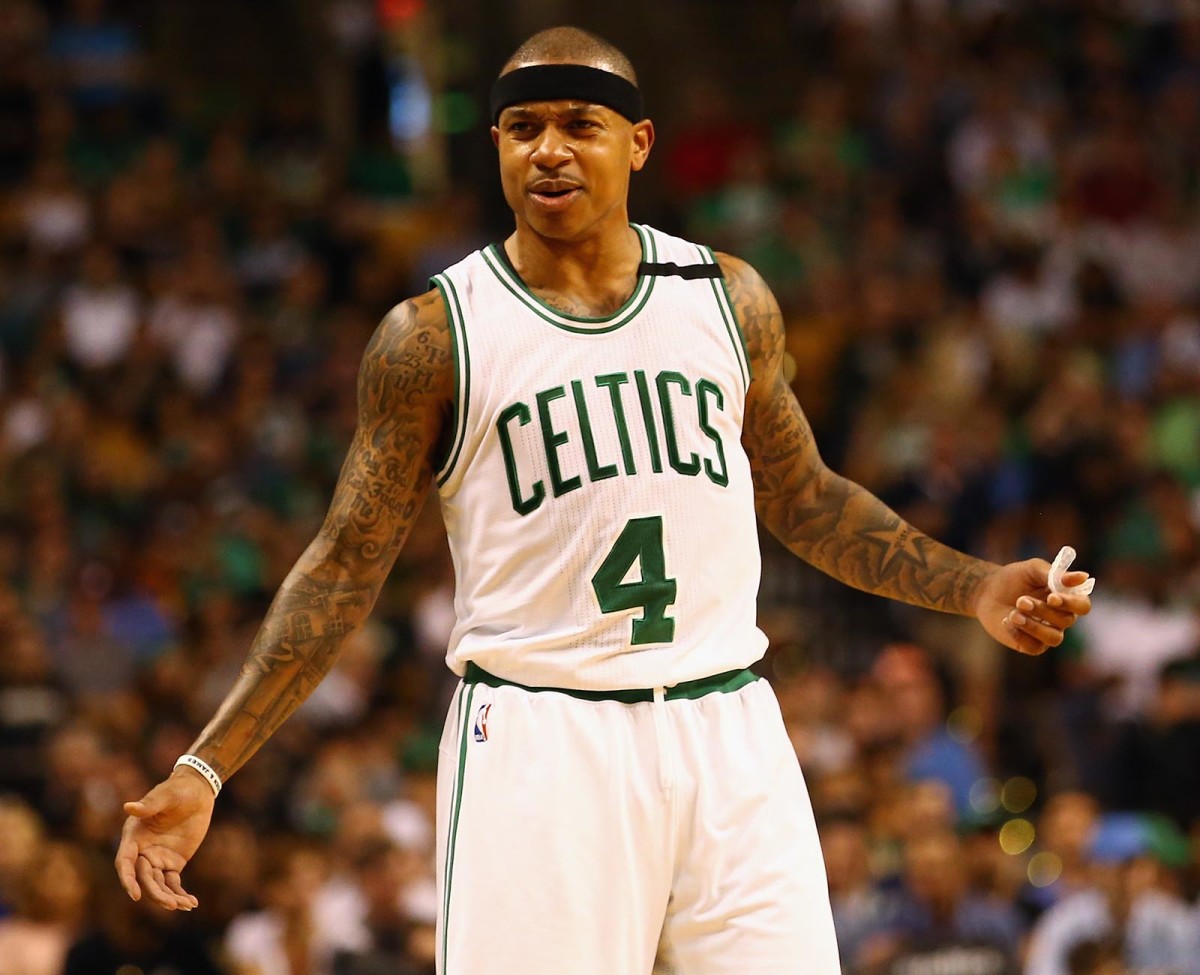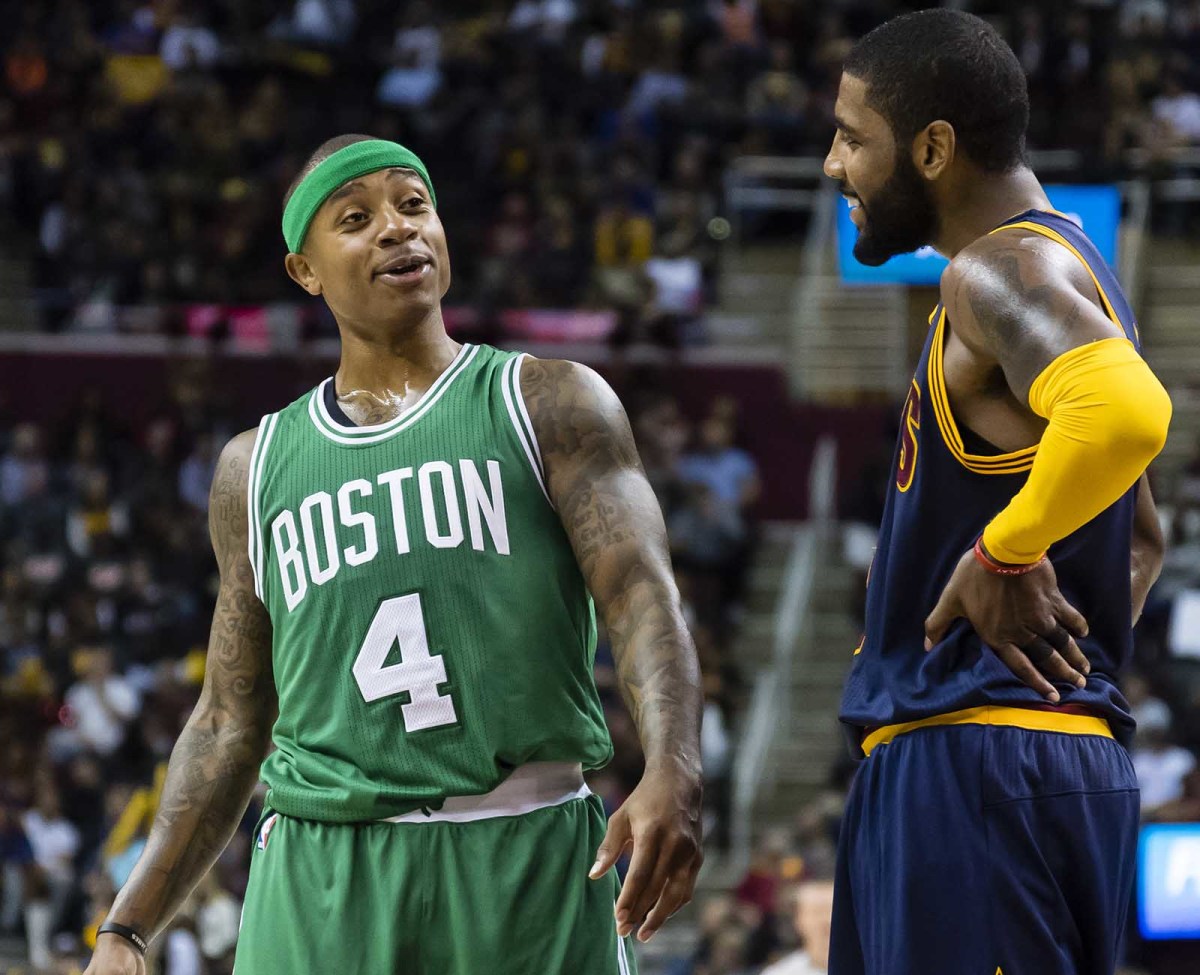Could Isaiah Thomas's Hip Injury Derail the Cavs-Celtics Trade?

As awkward as it might be, there's a chance Tuesday's blockbuster trade involving Isaiah Thomas and Kyrie Irving doesn't go through.
According to ESPN’s Adrian Wojnarowski, the Cavaliers are concerned about Thomas’s hip after the point guard underwent a team physical. Thomas has battled a significant hip injury since March 15, when the 5’9" All-Star suffered a right femoral-acetabular impingement with labral tear in a game against the Wolves. Thomas would miss a couple of games but came back and played without restriction.
Thomas then re-aggravated the injury during the playoffs, first during the Celtics' second-round series against the Wizards and a second time during Game 2 of the Eastern Conference finals. The second re-aggravation ended his season.
Thomas, with the Celtics' backing, has declined surgery. He has instead relied on rest and physical therapy in hopes of obtaining a full recovery. As of July 26, the plan seemed to be going well. Back then, Ainge toldThe Boston Globe's Adam Himmelsbach that Thomas was “out on the court; he's shooting.” Ainge added that Thomas was “full-speed ahead on the stationary bike and working in the swimming pool. He's progressing nicely." Ainge seemed cautiously optimistic that Thomas would be available at the start of training camp.
Ainge appeared more guarded of Thomas’s health during a conference call on Aug. 22. Ainge acknowledged that the hip injury played a role in his decision to trade Thomas and that “there’s probably a little bit of delay for Isaiah to start this year.”
Could the Cavaliers void their trade with the Celtics if they find Thomas's hip unfit? Let's examine their case.

How the NBA rules on rescinding a trade relate to Thomas
Paragraph 10 of the NBA’s uniform player contract requires that a traded player, “immediately upon reporting” to his new team, “submit upon request to a physical examination.” The new team designates a physician to conduct the physical.
The requirement of the physical has led to complications in NBA trades. Occasionally a team has rescinded a trade after giving a player a close look.
For example, in 2016, the Pistons rescinded a trade involving Donatas Motiejunas from the Rockets. The trade recession occurred after Pistons’ doctors evaluated Motiejunas’s back injury and were more concerned by it then at the time of the trade. As Pistons general manager Jeff Bower said, “standard with all trades, medical clearance on all players involved is required for completion.”
Usually no one involved in a trade wants to see it rescinded. Even a trade without controversy is disruptive in that it requires players to suddenly relocate their lives to a different part of the country. But a rescinded trade adds to the disruption. For teams to walk back a completed trade following a player’s physical can impair relations between front offices—the team that traded the player may feel that the new team is using the physical as a way of getting out of a trade; the team that traded for the player may believe the other team wasn’t fully honest about the player’s health.
A rescinded trade can also unintentionally malign the player in question as “damaged goods.” This can be particularly damaging to a player—like Thomas—who is entering his season before free agency. While the player can overcome the “damaged goods” label by staying healthy, it is still damaging to his reputation.
The NBA has rules in place to reduce the likelihood of a trade being rescinded. These rules are designed to maximize available information to a team before a trade occurs.
To that end, NBA Bylaw 4.03 makes clear that teams must share “all relevant information” about a player’s “current or prior injuries, illnesses, or other health conditions that could affect the player’s ability to play skilled basketball at any point during the player’s career.” Further, no team “shall misrepresent or fail to disclose any such relevant information.”
These disclosures must be made during a conference call with the NBA—the “trade call”—in which the teams notify the league of the trade and state the terms and conditions of the trade. Teams that fail to provide “all relevant information” can be subject to a fine of up to $1 million and be required to forfeit or transfer draft picks.
As the Celtics would stress, Thomas’s hip injury was obviously not concealed. Just the opposite, the injury was well known to the public for months. Also, the Celtics presumably shared all relevant information about the injury in conversations with the Cavaliers. The Cavaliers, then, knew they were trading for an injured player.
But full disclosure of Thomas’s health doesn’t preclude the possibility that the Cavaliers could view the injury differently upon seeing it up close. Doctors can look at the same injury and disagree about its severity, recovery timetable and other qualities. Along those lines, certain aspects of Thomas’s injury might not have been knowable to the Cavaliers until their doctors examined Thomas in person.
In other words, both the Celtics and Cavaliers could have acted in good faith and still reached a different opinion about Thomas’s health.

Where does the trade go from here?
Presumably, both teams still want to see the trade happen. The Celtics believe Irving will become a franchise player. At 25 years old, Irving fits in well with the Celtics’ young and talented core. The Cavaliers view LeBron James and Thomas as a dominant 1-2 punch. The Cavaliers also regard the Nets pick as one that could land a star in the 2018 NBA draft. It would also be awkward for Thomas and Irving to now return to the Celtics and Cavaliers, respectively.
On the other hand, if the Cavaliers have concluded that Thomas’s injury is worse than they believed at the time of the trade, the value of the trade has been altered. They have to ask themselves: would they still have made the trade had they known then what they know now?
This is particularly important since Thomas is set to become a free agent next summer. If the Cavaliers now believe Thomas will miss some portion of the regular season, he is arguably not as valuable to the franchise as he was at the time of the trade.
Is Anthony Davis the Celtics' End Game?
The Cavaliers and general manager Koby Altman have three options.
Option 1: Do nothing. The Cavaliers could decide that while Thomas’s injury is worse than they believed, the team nonetheless knew it was taking a risk in trading for him. Besides, even if Thomas misses a portion of the regular season, it’s more important that he be available for the playoffs.
Option 2: Rescind the trade. The Cavaliers could notify the Celtics and NBA that Thomas failed his physical and thus the transaction cannot move forward. This seems like the least probable outcome given that—as noted above—both teams view the trade as mutually beneficial. And, to say the least, it would be uncomfortable for all involved to unwind this particular trade.
Option 3: Re-negotiate the trade with the Celtics. By “re-negotiate” the Cavaliers would demand added compensation from the Celtics, who are set to have many draft picks over the next few years. The deal could be re-worked to include additional players (whose salaries must be compatible with the salary cap) or draft picks.
But the Celtics could simply say no. Ainge could insist that he already shared all relevant information and that the Cavaliers are using Thomas’s physical as pretext to renege on the trade. Ainge could call Altman’s possible bluff and tell him if he wants Irving back, then go void the trade.
Who will blink first?
Michael McCann, SI's legal analyst, provides legal and business analysis for The Crossover. He is also the Associate Dean for Academic Affairs at the University of New Hampshire School of Law.
